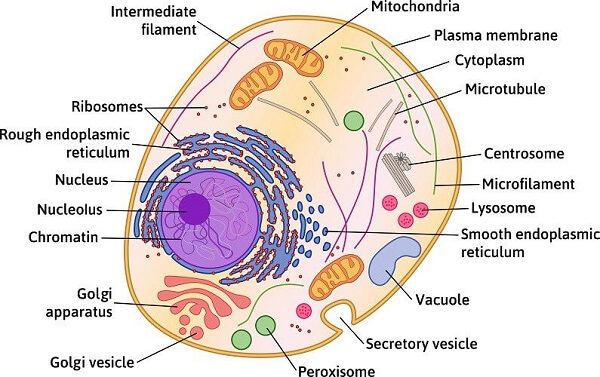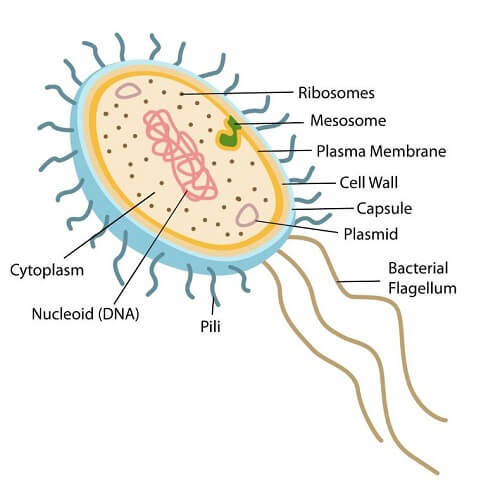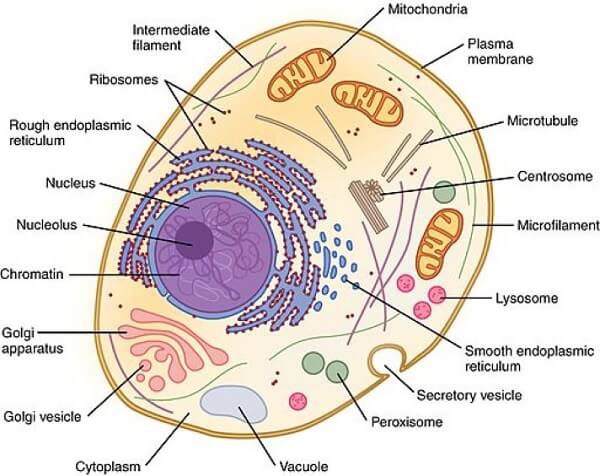What is a Cell
A cell can be defined as the smallest and basic unit of life. We can say that it is the structural and fundamental unit of life as all living organisms are made up of cells. We can say that cells are the building blocks of all living organisms. An organism may be made up of a single cell, which is known as a unicellular organism, whereas organisms, which are made up of multiple cells are known as multicellular organisms such as animals, humans, etc.
Discovery of cells I Who discovered cell?
In 1665, cell was discovered by Robert Hooke. He discovered cells when he was observing a piece of bottle cork under a microscope. He saw minute structures that looked like small rooms. He named these minute structures as cells. However, he was not able to see the details inside the cells due to the low magnifying power of his microscope. So, according to him, these cells were non-living entities.
Later, in 1673, when Anton Van Leeuwenhoek observed these cells under a microscope with higher magnification, he found some movement in the cells and based on this observation, he concluded that these cells were alive. Later, after observing these cell multiple times, he named these minute entities as animalcules which means little animals.
Later, in 1883, Robert Brown, who was Scottish botanist, was able to see and describe the nucleus present in the cells of orchids. Thus, he provided the first insight into the cell structure.
Structure of a Cell I Parts of a Cell
A cell has two main parts a nucleus and cytoplasm. It can perform different functions and can be of different shapes and sizes. Parts of a cell are described as follows;

1) The cell membrane: A cell is surrounded by a membrane which is known as the cell membrane or plasma membrane. It is a protective layer or boundary that separates the cell’s content from the materials outside the cell (extracellular environment). This membrane controls the transport of substances into and out of the cell. The cell membrane comprises a double layer of phospholipid molecules and proteins that provide structural support to membrane and form channels to allow movement of materials across the membrane.
2) Nucleus and Nucleolus: It is located at the centre of the cell and is separated from the cytoplasm (gel-like fluid inside the cell) by a double membrane that is called nuclear envelope or nuclear membrane. The gel-like material present in the nucleus is called nucleoplasm. The genetic material (DNA) of the cell is present inside the nucleus. It controls growth and reproduction of the cell. The shape of the nucleus is generally round, however, it can be oval or disc-shaped based on the cell type. It is the largest organelle inside the cell that can be easily seen under the microscope. The nucleolus is a densely stained region found in the nucleus and assists in producing ribosomes.
3) Cytoplasm: It is a gel-like material or fluid present inside the cell and is surrounded by the cell membrane. It mostly comprises water, salts and proteins. The organelles of the cell remain suspended in the cytoplasm. It is the material that is inside the cell but outside the nucleus. So, it does not include the nucleoplasm.
4) Cell organelles: These are small structures present in the cytoplasm. They remain suspended in the cytoplasm and perform specialized functions that are vital in maintaining necessary homeostasis in the cell. Such as producing energy, building proteins, destroying toxins, responding to external stimuli. An organelle can be membranous (with membrane) or non-membranous (without membrane). A membranous organelle has its own plasma membrane that separates its lumen from the cytoplasm. For example, Endoplasmic Reticulum, Mitochondria, Golgi body, etc. Examples of non-membranous organelles include Ribosomes, Centrosome, etc.
Functions of Cell
Cells perform all vital functions that are essential for the survival and growth and development of a living organism. Some of the major functions of cells are listed below:
- Support and Structure: The cell membrane and cell wall (mainly present in plant cells) are the main components that maintain the shape and structure of cells and thus provide support and structure to living organisms. For example, skin that is made up of cells provide support to humans and similarly, cells of xylem in plants provide structural support to the plants.
- Facilitate Growth: Mitosis is a process in which a cell divides into daughter cells. Thus, a cell produces new cells through mitosis and thus the growth of an organism takes place.
- Transport of Substances: Transport of substance takes place across the cell membrane. Nutrients are transported into the cells to perform various vital processes in the cell. The waste products produced inside the cell are removed by active and passive transport.
- Energy Production: The cells produce energy that is needed to carry out chemical processes inside the cell. The plant cells produce this energy through photosynthesis whereas the animal cells produce this energy through a process called respiration.
- Aid in Reproduction: A cell can divide itself into two or more daughter cells through mitosis and meiosis. Without cell division, new organisms cannot be formed or take birth.
Types of Cells
Cells are like factories with workers and different departments that work in coordination with each other to achieve a common goal. The cells can be of two types based on their structure; Prokaryotic and Eukaryotic.
Prokaryotic cell: This type of cell does not have a true nucleus which means a membrane-bound nucleus. It also lacks membrane-bound organelles. Its genetic material is circular and is made up of a single strand of DNA and is found in the central part of the cell called the nucleoid. The DNA strand remains suspended in the cytoplasm due to the absence of a membrane-bound nucleus.

These cells reproduce by asexual means of reproduction without forming gametes. Besides this, prokaryotic cells are typically smaller in size that ranges from 0.1 to 5.0 micrometre in diameter. The organisms that are made up of prokaryotic cell are called prokaryotes such as bacteria and archaea. Prokaryotes are always unicellular organisms which mean made up of a single prokaryotic cell.
Eukaryotic cell: A eukaryotic cell is a cell that has a true nucleus which means a membrane-bound nucleus. It also has membrane-bound organelles. The large and complex organisms like plants, animals, protists are made up of eukaryotic cells.

The genetic material (DNA) in a eukaryotic cell is contained within a membrane-bound nucleus. It also contains mitochondria that is one of the important cell organelles, which is responsible for producing energy for the use of cell. The eukaryotic cell size ranges from 10 micrometres to 100 micrometres.
Major difference between a prokaryotic and eukaryotic cell in tabular form:
| In term of | Prokaryotic Cell | Eukaryotic Cell |
|---|---|---|
| Type of Cell | A prokaryotic organism is mostly unicellular. | A eukaryotic organism can be unicellular or multicellular. |
| Cell Size | Small: ranges from 0.2 micrometres to 2.0 micrometre | Large: ranges from 10 micrometres to 100 micrometre |
| Cell Wall | Mostly present and is complex in nature | Mostly present in fungi and plant cells and is simple in nature |
| Nucleus | A well-organized membrane-bound nucleus is absent. | A true membrane-bound nucleus is present. |
| DNA | The genetic material (DNA) is circular, present in the nucleoid, a region in the cytoplasm. | DNA is linear and is present in the nucleus. |
| Chromosomes | Single | Multiple |
| Cytoplasm | Present, but does not contain cell organelles | Present and contains cell organelles |
| Mitochondria | Absent | Present |
| Ribosomes | Small size and spherical shape and suspended in the cytoplasm or attached to the cell membrane | Large size and linear in shape and attached to the rough endoplasmic reticulum |
| Endoplasmic Reticulum (ER) | Absent | Present |
| Golgi apparatus | Absent | Present |
| Lysosome and peroxisome | Absent | Present |
| Mesosomes | Present and performs the role of mitochondria, Golgi bodies and also assist in the separation of chromosomes during cell division | Absent |
| Cell division | It occurs through binary fission. | It occurs through mitosis. |
| Reproduction | Only asexual mode of reproduction can be seen | Both asexual and sexual modes of reproduction occur |
| Transcription | Occurs inside the cytoplasm | Occurs inside the nucleus |
| Examples: | Bacteria, Archaea | Protists, fungi, plants, animals and humans, etc. |
